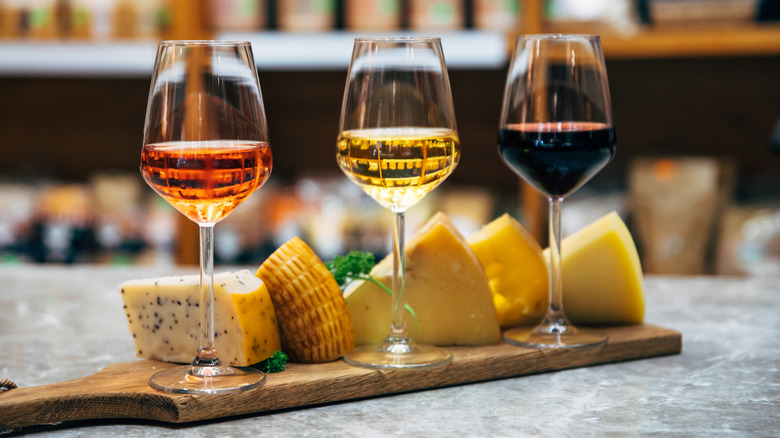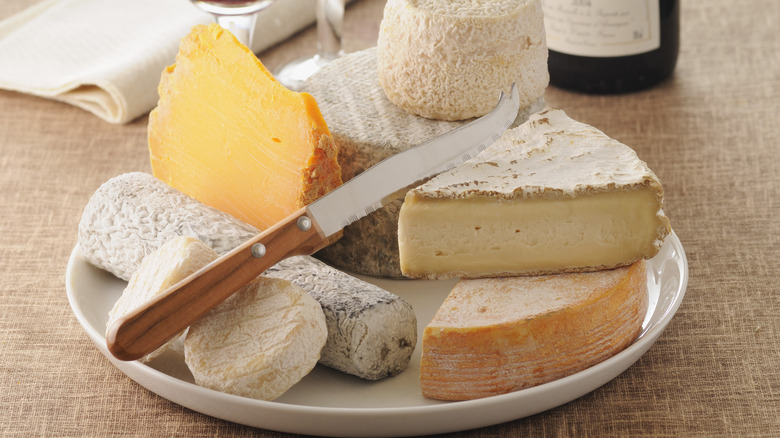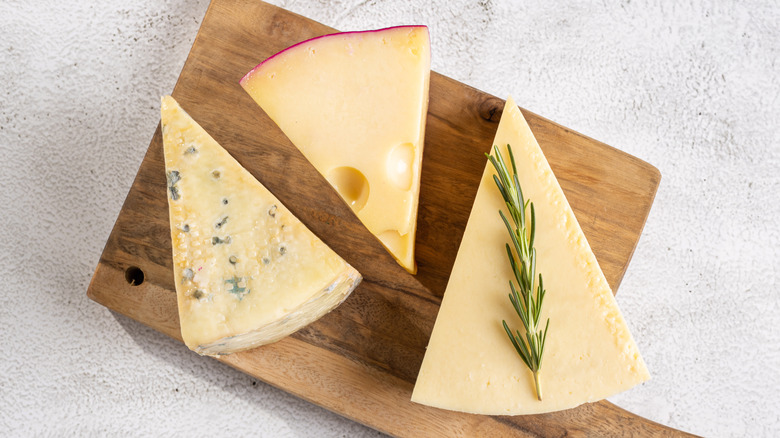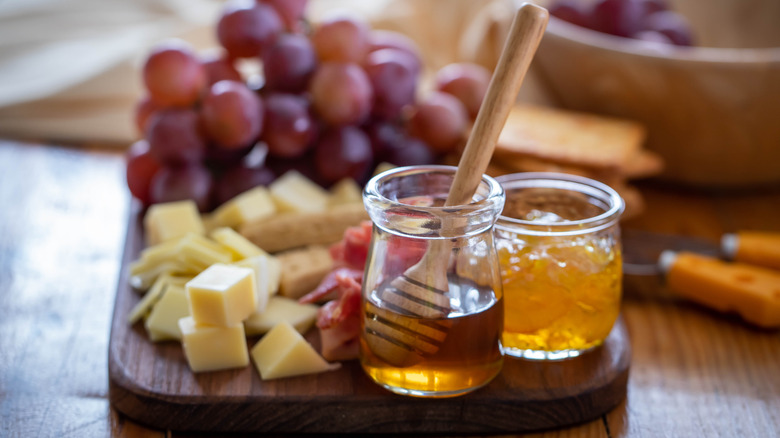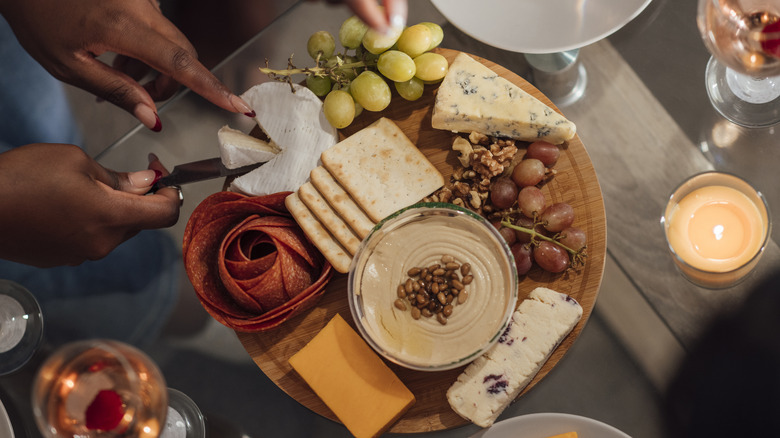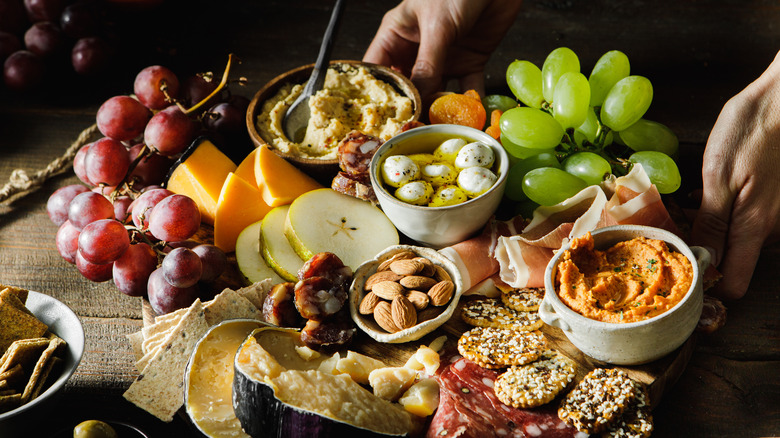A Cheesemonger Explains The Most Important Rules For Pairing
Few foods pair better with alcohol than cheese. There are plenty of classic wine and cheese pairings, but craft beer and cheese can also be a match made in heaven, much like a pairing of cheese and spirits. If you want to enjoy this snack alongside your favorite boozy beverages, however, there are many factors to consider, especially if you're constructing an entire charcuterie board. Kathleen Serino, training and curriculum manager at Murray's Cheese, spoke with Daily Meal and shared how to create the perfect wine and cheese pairing (and how to pair cheese with other things, too).
She said that one end-all-be-all rule for making great cheese pairings is to use "common sense blended with a little bit of courage." That means focusing on freshness and temperature and not being afraid to branch out. As she told Daily Meal, "You should be fearless and experimental (just search the hashtag 'unhinged cheese pairings' on social media to dive down a whimsical rabbit hole and you will get the idea)!"
Serino also noted, "At Murray's, we suggest three basic pairing principles I live (and would die) by." These rules — "like with like," "what grows together goes together," and "opposites attract" — will help you pair not just cheese, but also other ingredients on your smorgasbord. At the end of the day, Serino reassured us that you can always "ask your local cheesemonger or wine steward for advice if you are feeling lost."
Freshness plays a pivotal role
One major factor in creating a solid cheese-and-wine pairing is to work with fresh ingredients. Kathleen Serino told Daily Meal, "Regarding freshness, the beverage shouldn't be corked, or stale, or abused by wild swings in storage climate." Additionally, if your alcohol has expired, it could take on an odd flavor or have weaker tasting notes than usual. All of this will ultimately affect how it works with your cheese.
Where beverages are concerned, think about how opening a bottle will affect your drink. Serino reminded us that "with wine, you should open it for a spell before drinking, or [you should] decant aged wines." This won't just help your wine's flavors relax and open up — it will also boost the wine's taste, leading to a more enjoyable pairing experience. Just make sure you don't leave it for too long, as too much oxidation may cost you some of the wine's vibrancy.
Regarding the cheese, Serino said it "should absolutely be fresh (as in freshly cut from the wheel, or newly opened, and should not give any indication that is overripe or anything like that)." Although cheeses can last for several days to several weeks depending on the variety, their flavor and aroma can change over time. These factors will ultimately change how they work alongside your favorite alcoholic beverages, and any changes may throw off your pairing.
Get the temperature right
Beyond freshness, it's important to think about how warm or cold your drinks and cheeses are. Kathleen Serino explained to Daily Meal that your food's temperature can actually change how it tastes on your palate, saying, "Anything not where it is supposed to be in terms of appropriate drinking/eating/serving experience can influence the organoleptic experience."
For instance, sweet and bitter notes become more noticeable as your food or drink warms, so a slightly astringent wine could become overpowering if its temperature gets too high. At the same time, cooler temperatures can help brighten acidity, leading to crisper-tasting whites or citrusy rosés. Keeping these factors in mind can help you choose what temperatures are right for serving your cheese and alcohol in order to enhance their respective flavor profiles.
Worth noting, however, is that some cheese may change slightly at room temperature. For instance, Serino mentioned that Manchego will release oils as it reaches room temperature, though she also noted that "This is perfectly normal and a natural occurrence, and you should not fear this." So, while you want to serve your food at the right temperature, you don't need to worry if you notice your cheese sweating.
Take note of similarities
As you pair cheese and alcohol, remember to consider the other flavors on your charcuterie board. Kathleen Serino told Daily Meal that "items of similar personalities have the potential to be a nice match." This notion of "similar personalities" encompasses several factors besides flavor, including texture, intensity, color, and mouthfeel. For instance, a mead could work well with a honey goat cheese, or you might match aged gouda — a cheese with nutty, butterscotch notes — with a wine that features those same flavors, such as port or burgundy.
In addition to this advice, Serino said that ingredients hailing from the same region often work well together. She offered "Parmigiano Reggiano, prosciutto di Parma, balsamic vinegar of Modena, and Lambrusco from the region of Emilia Romagna" as just one example. These pairings blend well since the climate and topography in the region where an ingredient is grown — as well as the surrounding culture — can affect not only the taste of your food but also how different items combine.
Pairings are all about balance
Another tip from Kathleen Serino that can help you create a great cheese pairing is to pay attention to balance. She suggested "bringing balance through contrast, such as sweet and salty, or sweet and bitter, hard and soft, milky and tart, etc." For instance, you might pair sweet chocolates with a bitter cheese-and-wine combo. This method will help you create a meal that doesn't heavily favor one flavor profile over another.
At the same time, finding balance also means that you shouldn't overload your charcuterie board with a certain type of snack. As an example, Serino said, "When there are too many sweet ingredients on the board (jams, candy, coated nuts, chocolate, etc.) and not enough fresh vegetables or fresh fruit, this is also a miss." She urged that you remember palate cleansers, which give your tastebuds a rest and restore their sensitivity so that you can detect all the nuances of your next snack. Bread, for instance, can be a great neutral palate cleanser that prepares you for your next bite of rich cheese or sip of flavorful wine.
Don't forget about convenience and aesthetics
Beyond flavor considerations, think about how you serve your charcuterie board, too. Kathleen Serino said it's important to "start with the ingredients that will take up the most space and build out from there." This will help you make a focal point, plus it makes serving (and eating) your snacks easier and covers more of the board's surface area. Similarly, Serino mentioned that you should pre-cut your cheese not only to cover more of the board but also so the cheese is easier to grab. She did mention, however, that "An exception to this would be super soft and runny cheeses or an austere presentation wedge of really good cheese. In this case, I would just stick a knife in it!"
Yet another factor to consider is that, as you add cheeses to your charcuterie board, you may find that you have gaps in some areas. If this is the case, you can fill in the spaces with nuts and other small bites, adding a pop of color and covering empty regions of the board.
Serino also mentioned that, while it's fine to play around with pairing other snacks with your cheeses — such as fruits, jams, and veggies — you shouldn't lose sight of the main event. She explained that "there is nothing wrong with enjoying a cheese on its own, especially if it is delicious."
